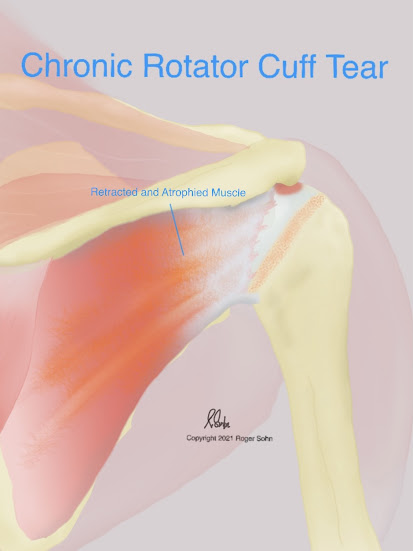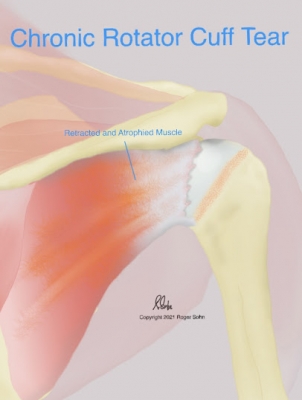What is the difference between acute and chronic rotator cuff tendon tears?
"Acute", in the medical sense, means something that happened very recently. Acute rotator cuff tears, typically happen due to an injury or accident. People with those types of injuries can often remember how they hurt the shoulder and exactly when the pain started. "Chronic" means something that has been there for a prolonged period of time. Chronic tears of the rotator cuff happen over the course of time due to wear and tear. Folks who have a chronic rotator cuff tear describe the onset of their pain as gradual. They don't usually remember a specific injury. Instead, they will tell me that the pain has been getting worse in recent months.
How do you diagnose a chronic rotator cuff tear?
Many people come to me complaining of shoulder pain that has been present off and on for several years. We often obtain an MRI of their shoulder and the MRI shows what appears to be a chronic tear. Chronic just means the tear has been there for quite some time, resulting in some signature changes to the tendon and muscle. Specifically, the tendon is detached and retracted far away from its normal attachment point on the humerus. We also see shrinkage or atrophy of the muscles. In late stages, the muscle is actually infiltrated by fat, resembling the marbling of fat we see in kobe beef.


When a rotator cuff remains torn for several years, it begin to atrophy and scar down to the surrounding tissues.
What are the treatment options for a chronic rotator cuff tear?
These changes are important to note because it helps us to decide what the viable treatment options are. While many people can improve with a course of physical therapy, about 30% of people with such a tear are unable to fully return to normal function. In these folks, we need to do something more to help them get their lives back.
One such option is to transfer an expendable or "extra" tendon and attach it to the shoulder. The most commonly used tendon is the lower trapezius. We can detach the lower portion of the muscle and tendon from the scapula. We can then connect the tendon to the humerus using a tendon allograft. This restores the strength and ability of the shoulder to lift and rotate. The tendon allograft we use is usually an achilles tendon from the tissue bank. These tendons are carefully prepared and tested to avoid transmitting diseases such as viruses or bacteria. Thankfully, this type of tissue transplantation does not require any type of anti-rejection drug.

After surgery, patients wear a special brace for 6 weeks. After that, they begin physical therapy and generally can resume all normal activities around 4 months after surgery.
Coming soon...
We will discuss other options such as superior capsule reconstruction and reverse shoulder replacement. We will also discuss newer options such as the balloon spacer that has been recently approved by the FDA.


